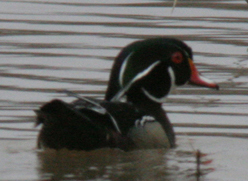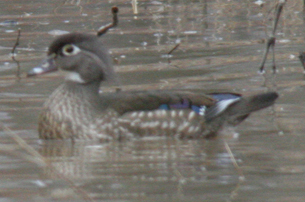Wood Duck
General:
The Wood Duck is a species of duck found in North America and a popular game bird. The Wood Wood Duck (Carolina Duck) – Aix sponsa is one of the most beautiful American ducks. It is second only to the Mallard in numbers shot each year in the United States.
The population of the Wood Duck was in serious decline in the late 19th century as a result of severe habitat loss and market hunting both for meat and plumage for the ladies’ hat market in Europe. By ending unregulated hunting and taking measures to protect remaining habitat, wood duck populations began to rebound in the 1920s. Wood Duck populations are stable today.
Wood Ducks nest in trees near water, sometimes directly over water, but other times up to 1 mile away. After hatching the ducklings jump down from the nest tree, from heights of up to 50 ft without injury and make their way to water. The mother does not help them in any way.
Wood Duck eggs are creamy white. Chicks hatch in 28-37 days and in one day are able to leave the nest in one day. They fledge in 56-70 days
Identification:
The Wood Duck is about 19″ in length with an average wingspan of 29″, about 3/4 that of a Mallard.
 Male wood ducks have a crested head that is iridescent green and purple with a white stripe leading from the eye to the end of the crest, and another narrower white stripe from the base of the bill to the tip of the crest. The throat is white and the chest is burgundy with white flecks, gradually grading into a white belly. The bill is brightly patterned black, white and red.
Male wood ducks have a crested head that is iridescent green and purple with a white stripe leading from the eye to the end of the crest, and another narrower white stripe from the base of the bill to the tip of the crest. The throat is white and the chest is burgundy with white flecks, gradually grading into a white belly. The bill is brightly patterned black, white and red.
Female wood ducks have a gray-brown head and neck with a brownish, green, glossed crest. A white teardrop shaped patch surrounds the brownish-black eye. The throat is white and the breast is gray-brown stippled with white, fading into the white belly. The back is olive brown with a shimmer of iridescent green. The bill is blue-gray and the legs and feet are dull grayish-yellow.
Habitat:
Found in forested wetlands, including along rivers, swamps, marshes, ponds, and lakes.
Territory:
Two main territories – British Columbia south to Washington. Winters south into California,. East – Minnesota to Nova Scotia South south to Florida and Texas. Winters as far north as New Jersey.
Food:
Seeds, acorns, fruits, aquatic and terrestrial invertebrates. The Wood Duck dabbles on water surface, it may tip-up or dive for submerged food items.
Credits:
Patuxent Bird Identification InfoCenter
The Audubon Society – Field Guide to North American Birds (Eastern Region)
Wikipedia, the free encyclopedia
Cornell Lab of Ornithology
